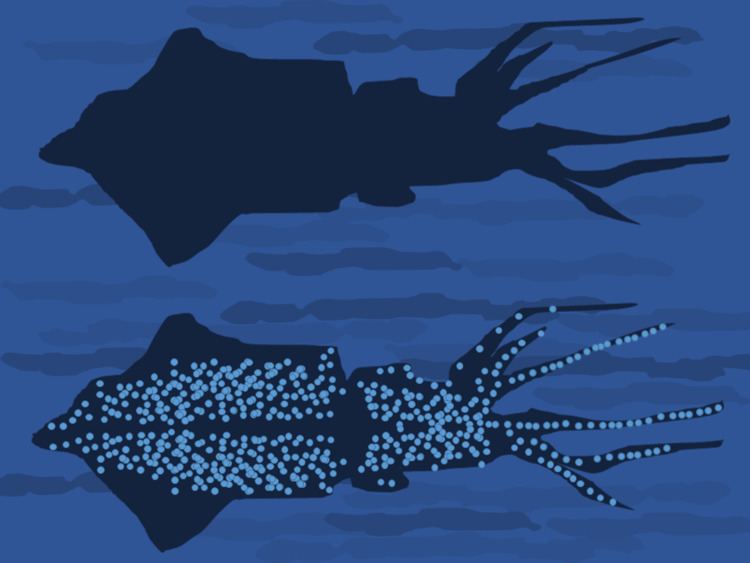 | ||
Counter-illumination is a method of active camouflage seen in marine animals such as firefly squid and midshipman fish, and in military prototypes, producing light to match their backgrounds.
Contents
Marine animals of the mesopelagic (mid-water) zone tend to appear dark against the bright water surface when seen from below. They can camouflage themselves, often from predators but also from their prey, by producing light through bioluminescence on their lower surfaces, reducing the contrast of their silhouettes against the background. Counter-illumination differs from countershading, which uses only pigments such as melanin to reduce the appearance of shadows. It is one of the dominant types of aquatic camouflage, along with transparency and silvering. All three methods make animals in open water resemble their environment.
Counter-illumination has not so far come into widespread military use, but during the Second World War it was trialled in ships in the Canadian Diffused lighting camouflage project and in the American Yehudi lights project.
In marine animals
Among marine animals, counter-illumination camouflage occurs where bioluminescent light from an organism's ventral surface is matched to the light radiating from the environment. The bioluminescence is used to obscure the organism's silhouette produced by the down-welling light. Counter-illumination differs from countershading, also used by many marine animals, which uses pigments to darken the upper side of the body. Counter-illumination goes further than countershading, actually brightening the under side of the body.
The bioluminescence used for counter-illumination can be either autogenic (produced by the animal itself, as in pelagic cephalopods such as Vampyroteuthis, Stauroteuthis, and the Bolitaenidae) or bacteriogenic (produced by bacterial symbionts). The luminescent bacterium is often Aliivibrio fischeri.
Reducing the silhouette is primarily an anti-predator defence for mesopelagic (mid-water) organisms. The reduction of the silhouette from highly directional down-welling light is important as there is no refuge in the mesopelagic, and predation occurs from below. Many mesopelagic cephalopods such as the firefly squid, decapod crustaceans, and deep ocean fishes use counter-illumination; it works best for them when ambient light levels are low, leaving the diffuse down-welling light from above as the only light source. At night, nocturnal organisms match the wavelength and light intensity of their bioluminescence to that of the down-welling moonlight and direct it downward as they swim, to help them remain unnoticed by any observers below. This strategy halved predation among individuals employing it compared to those not employing it in midshipman fish.
Besides its effectiveness as a predator avoidance mechanism, counter-illumination also serves as an essential tool to predators themselves. Some shark species, such as the deepwater velvet belly lanternshark, use counter-illumination to remain hidden from their prey. as does the Hawaiian bobtail squid. Other well-studied examples include the cookiecutter shark, the marine hatchetfish, and the Hawaiian bobtail squid. More than 10% of shark species may be bioluminescent, though some such as lantern sharks may use the light for signalling as well as for camouflage.
Military prototypes
Active camouflage in the form of counter-illumination has rarely been used for military purposes, but it has been prototyped in ships and aircraft from the Second World War onwards.
For ships
"Diffused lighting camouflage", in which visible light was projected on to the sides of ships to match the faint glow of the night sky, was trialled by Canada's National Research Council and then by the Royal Navy during World War II. Some 60 light projectors were mounted all around the hull and on the ships' superstructure such as the bridge and funnels. On average, the system reduced the distance at which a ship could be seen from a surfaced submarine by 25% using binoculars, or by 33% using the naked eye. The camouflage worked best on clear moonless nights: on such a night in January 1942, HMS Largs was not seen until it closed to 2,250 yards (2,060 m) when counter-illuminated, but was visible at 5,250 yards (4,800 m) unlighted, a 57% reduction in range.
For aircraft
The Canadian concept was trialled in American aircraft including B-24 Liberators and TBM Avengers in the Yehudi lights project, using forward-pointing lamps automatically adjusted to match the brightness of the sky. The goal was to enable a radar-equipped, sea-search aircraft to approach a surfaced submarine to within 30 seconds from arrival before being seen, to enable the aircraft to drop its depth charges before the submarine could dive. There was insufficient electrical power available to illuminate the entire surface of the aircraft, and outboard lamps would have interfered with the airflow over the aircraft's surface, so a system of forward-pointing lamps was chosen. These had a beam with a radius of 3 degrees, so pilots had to fly with the aircraft's nose pointed directly at the enemy. In a crosswind, this required a curving approach path, rather than a straight-line path with the nose pointed upwind. In trials in 1945, a counter-illuminated Avenger was not seen until 3,000 yards (2,700 m) from its target, compared to 12 miles (19 km) for an uncamouflaged aircraft.
The idea was revisited in 1973 when an F4 Phantom was fitted with camouflaging lights in the "Compass Ghost" project.
